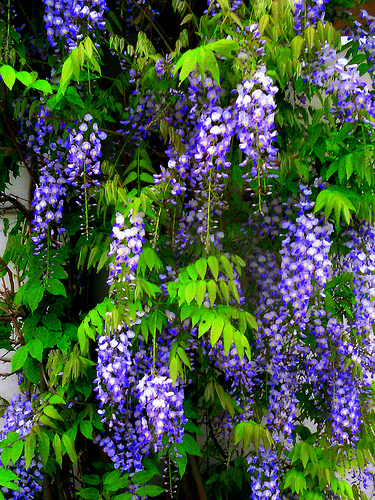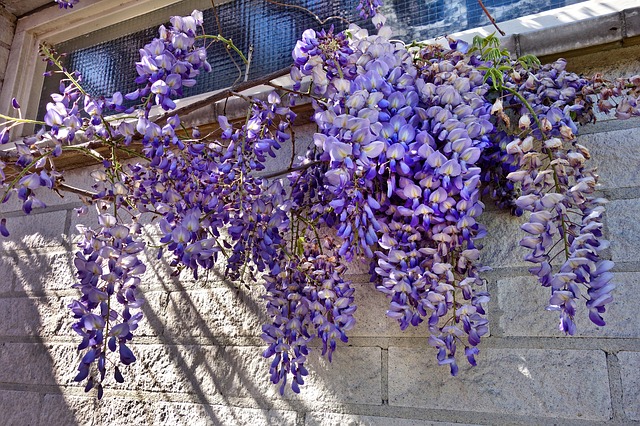Chinese Wisterias – How To Grow And Prune

Gardening Question from Jody:
I walked by your house yesterday and saw your wisteria in full bloom. I planted one three years ago and it has barely begun to grow. How long will it take to get to be like yours? And how do you prune it?

Answer from Pat:
My wisterias are 30 years old. Wisteria needs good drainage. I planted six of them. Two died from root rot but there were still plenty left to cover my 50-foot long pergola. Fertilize and water wisteria well for the first three years to get it started. Don’t let it become a tangled mess but arrange all twiners to climb up posts clockwise for Japanese wisteria and counter-clockwise for Chinese wisteria. Mine are Chinese wisterias (Wisteria sinensis ‘Cooke’s Special’.) Once your vine reaches the top of your pergola, climb a step ladder every week and grab the twiners and tie them gently in place straight down on top of the pergola. Once it has covered the entire length, then begin pruning by cutting back the twiners to two buds every summer all summer long. This produces much more bloom such as you see on my wisterias and every time you cut back a twiner it will sport one bloom so your vines will bloom a little all summer long.
Through the years, I have pruned my wisterias with great care, removing all twiners back to one or two buds all summer long every summer. I have taught Raymundo to do this, leaving stubs, not cutting clean off. Every bud he leaves on the plant at the base of a twiner will then become a new “spur” which will bear blooms the following spring. In this way Raymundo cuts off the twiners every week beginning just after bloom stops and lasting to late August or when the vine stops producing them. I provide him with long reach pruners so he can stand on the walkway under the pergola to do this job.
Additionally, the whole thing reached enormous size. So a couple of years ago I also reduced hundreds of pounds of heavy wood. With the help of a woman gardener who sometimes helps me, she and I cut back and removed heavy wood several times from late April to September, cutting back to leafy growth each time so it would sprout leaves down further. Then we cut back to that and so forth. Unfortunately, my Spanish is not good enough to explain all this to Raymundo. That is why I had to do it myself. In other words without ever making a cut into old bare wood, which is a mistake folks make, then the wisteria will never bloom again for its full length, but only on the tips. By incorrect pruning you can lose that look forever. But by slowly waking up the buds further back, many buds further back have woken up again and now some of my wisterias still bloom all the way to the ground like they did 30 years ago.
Photo by kkimpel 
Photo by Stiller Beobachter 


Hi, I planted a bare root blue wisteria over a year ago and it grew some last year but it hasn’t yet begun to grow leaves this year. I think it might be dead; shouldn’t it have leaf buds by this time? I’m so worried about it :/
It’s dead. Pull it out and start over. Begin again with barefoot plant next year or buy a good variety in bloom now. Prepare planting hole, make sure drainage is good. Fill hole twice and second time make sure water goes down at least an inch per hour. When you plant wisteria you must water and fertilize when the plant is young. When planting bare root soak the roots in water before planting. During the first 3 years of growth fertilize and water wisteria. After that, just water when rains are inadequate, no more need for fertilizer.
Was wondering if you could help me, I live in an area called Westlake Village in Ventura County , unlike your beautiful Del Mar, I am 1/2 hour away from Malibu.
For my wisteria vine and have built a heavy duty arbor for it. It is now blooming as it has warmed up a bit to 80 degrees. Can you recommend the best fertilizer for it? Also, when should it be trimmed? and how often? Planted it 2 years ago it was a foot tall and now about 14 feet tall but not too many flowers to my dismay.
Many thanks for your expert advice
Irrigate and fertilize wisteria with a balanced fertilizer for it’s first three years of growth to get your plant growing. After that, no fertilizer is needed. Your wisteria is so tall it no longer needs fertilizer so do not feed it. Flowers are not dependent on fertilizing but on correct pruning which I will explain below.
The main growth period of wisterias is in late spring and summer after blossoms fade. For first few years, arrange the twiners the way you want them to grow. The “twiners” are fresh new growth that begin sprouting after bloom and are long and thin and bears leaves. A twiner will reach out to grab anything and twine around it. When people do not control this stage what you get is a rat’s nest of growth. Do not let this happen. Instead, arrange the twiners first up a post that supports your pergola or arbor. Japanese species of wisteria twine clockwise and Chinese species twine counter clockwise. (This is 100% factual. Note at the tip of the twiner, which way it is trying to twine.) Start them going in the right direction up the post. Eventually these skinny twiners will become thick and make natural grafts. This will form the “trunk” of your vine, i.e.: the heavy, tree-like structure of your plant. On top of the arbor will be the “branches—twiners that will eventually grow thick and bear flowers and leaves and more growth you must cut back correctly to control and create more bloom for many years to come.
Chinese wisterias bloom on bare wood in a spectacular show of color prior to leaves growing. Japanese wisterias bloom at the same time as leaves emerge but the flowers are longer than Chinese varieties and they hang down below the leaves and the bloom period lasts longer.
Never plant a seed-grown wisteria since these may not bloom for 10 or 12 years. All of them are Japanese varieties with inferior flower color. Good, named varieties of both Japanese and Chinese wisterias are always grafted onto strong Japanese rootstocks. Always begin with a named variety. I recommend that gardeners cut off all of the long seed pods that look like beans. Beware since these are poisonous and certainly are not beans. By cutting them off one prevents having them plant themselves in one’s garden. This is why people don’t grow wisterias in the Deep South because in areas of regular rains they can become an invasive nuisance. In the West however they are a wonderful, spectacular and drought-resistant plant that provides food for birds. Birds love to eat the flower buds but there are so many flower buds that the damage never shows.
When your twiners have reached the top of your arbor, then arrange them in a straight line on the cross beams of your pergola or arbor and tie them gently in place. When your pergola or arbor is completely covered with this horizontal growth, then begin cutting back all unnecessary growth (new twiners.) Eventually this horizontal growth and also the structure up the posts will begin sending out many of these twiners after bloom until the beginning of August every year. Be sure to begin pruning these off as they appear but be sure not to cut them off flush with the older wood. Always be sure to leave one or two buds on the vine. There is a bud behind each new leaf or leaf scar. The short piece of new growth you leave on the vine will then form a “spur” (a short, misshapen twig, slightly thicker than a twiner that bears a few leaves and will bear fat flower buds that form in autumn and will bloom the following year.)
Like apple trees, wisterias bloom on spurs. Spurs may live as long as 15 years and they will bear most of the flowers every spring until they get old and fall off. Never cut them off unless they are dead. If you continue cutting back unwanted twiners this way you will have massive bloom in late winter or early spring the following year, most likely all the way to the ground. Continue cutting back unneeded twiners to one or two buds all summer long. In August the plant will stop growing until the following year.In late fall or early winter it will drop all its leaves and you will have to sweep them up. You can use these for mulch or add them to the compost pile. If you prune as I have described in summer, no winter pruning is needed except to remove anyslong, straight twiners you might have missed during summer. Remember, never cut off the spurs. Sometimes people who do not know better look at their wisteria vine in winter and say “Oh, that piece doesn’t look good. It’s ugly.” and they cut it off without realizing, poor souls that they are cutting off all the flower buds.